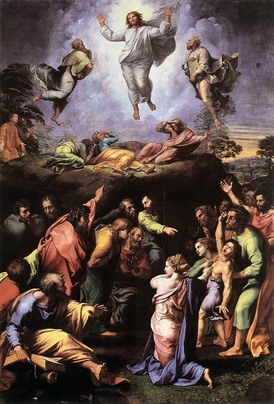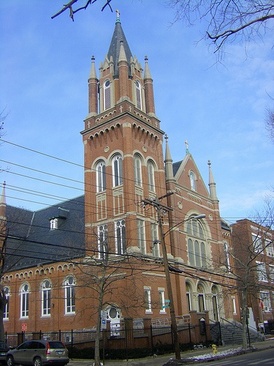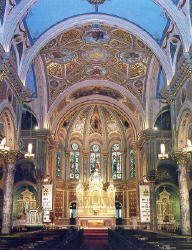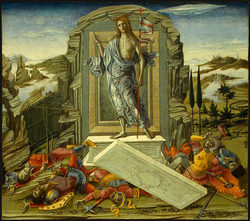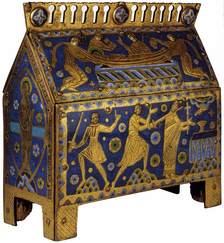 The US Bishops’ Committee on Divine Worship launched a new website today (on the liturgical memorial of St Pius X, no less!!!) that pulls together tons of info on the proposed new translation of the Novus Ordo Mass. The aim of the website is to educate us on the forthcoming Roman Missal. All I can say at the moment: THANKS BE TO GOD! What I’ve seen of the work on the this website looks pretty good and I look forward to more. Poke around…and familiarize yourself with what the Church is proposing in terms of praying the Mass. Notice that we are no longer calling the “big red book used at Mass by the priest” the “sacramentary” but the Roman Missal. The first step is a good one.
The US Bishops’ Committee on Divine Worship launched a new website today (on the liturgical memorial of St Pius X, no less!!!) that pulls together tons of info on the proposed new translation of the Novus Ordo Mass. The aim of the website is to educate us on the forthcoming Roman Missal. All I can say at the moment: THANKS BE TO GOD! What I’ve seen of the work on the this website looks pretty good and I look forward to more. Poke around…and familiarize yourself with what the Church is proposing in terms of praying the Mass. Notice that we are no longer calling the “big red book used at Mass by the priest” the “sacramentary” but the Roman Missal. The first step is a good one.
Tag: liturgy
The newest basilica decreed in Florida
On 22 August, Orlando’s National Shrine of Mary, Queen of the Universe will be formally recognized as a minor basilica at a Mass with the accompanying rites.
Transfiguration of the Lord
Christ Jesus, the brightness of the Father and the image of His substance, upholding all things by the word of His power, effecting man’s purgation from sin, has deigned to appear this day in glory on a high mountain.
St Stanislaus Church (New Haven, CT) to host the St Gregory Society
Archbishop Henry J. Mansell, Archbishop of Hartford, in a letter to the Saint Gregory Society of New Haven, Connecticut, gave his permission for the Traditional Latin Mass community to relocate from Sacred Heart Church in New Haven to Saint Stanislaus Church at 9 Eld Street in New Haven.
“He wants to be certain the church is appropriate for your needs,” wrote the archbishop.
He gave permission for the first Traditional Latin Mass at Saint Stanislaus in New Haven to be on The Feast of the Holy Cross, September 13, 2009. The Mass according to the 1962 Roman Missal will be celebrated at 2 pm at Saint Stanislaus just as it had been celebrated at 2 PM at Sacred Heart.
In his cordial letter of introduction, Archbishop Mansell encouraged cordial relations with the pastor, Father Roman Kmiec, C.M., pastor of Saint Stanislaus. Father Kmiec has indeed warmly welcomed the Saint Gregory Society.
Archbishop Mansell said he was “glad to help” the Saint Gregory Society in finding a new home for the Community.
Saint Stanislaus Church is staffed by the Congregation of the Mission (the Vincentians) of the New England Province. The Vincentians, an congregation of priests and brothers founded by Saint Vincent de Paul in the 1600s, spread the gospel message of Jesus in championing the needs of the poor.
The De Paul Provincial House is located at 234 Keeney Street in Manchester, CT.
I am happy to receive this news. I spent nine years of my formative years at Saint Stan’s with the Vincentians and the Congregation of the Holy Family of Nazareth. Saint Stan’s is New Haven’s best looking church maintaining the original artwork and liturgical furnishings.
The Saint Gregory Society of New Haven is a non-profit lay association founded in 1985 to promote the local celebration of the Traditional Latin Liturgy according to the Tridentine Missal in response to the Papal indult of October 3, 1984, Quattuor abhinc annos, which granted the use of the liturgical books in force in 1962.
Since January 1986, the Traditional Latin Mass regularly has been celebrated at the Sacred Heart Church in downtown New Haven. The Saint Gregory Society exists primarily to advocate the preservation of the immemorial rite of the Mass, to work for its celebration on a regular and unrestricted basis, and to disseminate information about and cultivate interest in the classical Roman liturgy and its central importance for Catholic faith and culture.
The Society supports a professional Schola Cantorum that provides the proper Gregorian chant and sacred polyphony for all sung liturgical functions.
For further information: saintgregorysociety@gmail.com.
(this article is edited & adapted)
Will there be a common date for Easter? Ever?
Do you ever think of the (dis)unity of Christians? Are you concerned enough to pray for the unity of the Churches? Today after Mass I prayed a prayer that asked God the Father to give us the grace of unity among Christians while He also fixes the errors that exist among the same. A tall order I know but I am known for bold requests! For some time I’ve been praying that one day–in my lifetime– that among some Christian churches we can observe a common date of Easter if not also a common altar. Needless to say, I am saddened by the fact that most Christians don’t
have an issue with the various Christian churches and ecclesial communities celebrating
Easter on different days. I lament this apathetic approach to our observing THE most solemn day of our Lord and Savior’s triumph over sin and death.
a common date for Easter is nearly as old as Christianity itself. History
shows us that when the Apostles formed the various Christian communities under the power of the Spirit and by their work of evangelization differing opinions surfaced on how and when to commemorate Jesus Christ’s death
and resurrection. Most often differing opinions were based on how the four
gospels recorded the events of our salvation. We know the first attempt at
deciding a common date for Easter began with the Council of Nicaea (325). The
Council taught that the date of Easter would be the first Sunday after the full
moon following the vernal equinox. However, there was no method for calculating
the full moon or the vernal equinox.
the Western tradition base
their calculations on the Gregorian calendar. Hence, a window of difference is five weeks exists. Hmmm!!!???
seminar in the Ukraine attended by Orthodox, Roman Catholic and Protestant
theologians of Europe, all participants endorsed a compromise proposed at a 1997 World Council of
Churches (WCC) consultation in Aleppo, Syria. Notice that no North American theologians’ opinions were considered. The proposal made was to keep the
Nicaea rule but calculate the equinox and full moon using the accurate
astronomical data available today, rather than those used many years ago.
Brilliant, if you ask me! Now I
wonder of the churchmen who head
these churches also agree.
Antoine Arjakovsky, director of the Institute of Ecumenical Studies, pointed
out: “Whilst the astronomic reckoning of the Nicean rule comes closer to
the Gregorian calendar than to the ancient Julian one, the Roman Catholic and
Protestant churches did take a step towards the Orthodox churches in Aleppo,
accepting that the date of Easter should be established on the base of a cosmic
calendar rather than by a fixed date as had been proposed prior to the
inter-Orthodox meeting in Chambésy in 1977.”
convergence of calendars which will produce a common Easter date that may, one hopes, serve as
an opportunity for all Christians to join together for a celebration that is
not based on mere coincidence. By Easter 2012 (April 8), can we hope that a
date based on exact astronomical reckoning and celebrated by all Christians?
seems that it’s not only theology or the calendar’s calculations that’s the
problem but the ecclesial relations among the communities of faith. Sad if you
ask me.
Translation of the Relics of Saint Thomas Becket
For many reasons I have had a devotion to Saint Thomas Becket whose liturgical memorial is observed on December 29. Becket was killed in 1170. His conversion and subsequent witness to the work of the Trinity in the world is one which inspires and challenges me to follow Christ more closely.
our sake Christ offered himself to the Father upon the altar for the cross. He
now looks down from heaven on our actions and secret thoughts, and one day he
will give each of us the reward his deeds deserve. It must therefore be our
endeavor to destroy the right of sin and death, and by nurturing faith and
uprightness of life, to build up the Church of Christ into a holy temple of the
Lord.
gather all of it into the granary of the Lord. Yet the Roman Church remains the
head of all the churches and the source of Catholic teaching. Of this there can
be no doubt.
Peter. Upon his faith and teaching the whole fabric of the Church will continue
to be built until we all reach full maturity in Christ and attain to unity in
faith and knowledge of the Son of God. Of course many are needed to plant and
many to water now that the faith has spread so far and the population become so
great.
unless what he plants is the faith of Peter, and unless he himself assents to
Peter’s teaching. All important questions that arise among God’s people are
referred to the judgment of Peter in the person for the Roman Pontiff. Under
him the ministers of Mother Church exercise the powers committed to them, each
in his own sphere of responsibility.
their salvation; remember the sufferings through which the Church has grown,
and the storms the ship of Peter has weathered because it has Christ on board.
Remember how the crown was attained by those whose sufferings gave new radiance
to their faith. The whole company of saints bears witness to the unfailing
truth that without real effort no one wins the crown.
Happy 4th of July
The Eucharistic sacrifice unites us with heaven
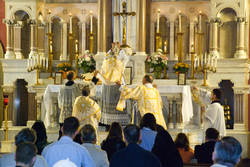 It is especially in the sacred liturgy that our union
It is especially in the sacred liturgy that our union
with the heavenly Church is best realized; in the liturgy, through the
sacramental signs, the power of the Holy Spirit acts on us, and with community
rejoicing we celebrate together the praise of the divine majesty, when all
those of every tribe and tongue and people and nation (cf. Apoc. 5:9) who
have been redeemed by the blood of Christ and gathered together into one Church
glorify, in one common song of praise, the one and triune God. When, then, we
celebrate the Eucharistic sacrifice we are most closely united to the worship
of the heavenly Church; when in the fellowship of communion we honor and
remember the glorious Mary ever virgin, St. Joseph, the holy apostles and
martyrs and all the saints. (Lumen gentium, 48)
J. Augustine DiNoia, Dominican & Archbishop
 Today, the Holy Father nominated Dominican Father Joseph Augustine Di Noia, 66, as the archbishop secretary of the Congregation for Divine Worship and the Disciple of the Sacraments. He is given the archepiscopal dignity and is assigned the Titular See of Oregon City.
Today, the Holy Father nominated Dominican Father Joseph Augustine Di Noia, 66, as the archbishop secretary of the Congregation for Divine Worship and the Disciple of the Sacraments. He is given the archepiscopal dignity and is assigned the Titular See of Oregon City.
Damian Thompson acknowledges that slop is all we seem to get when it comes to liturgical music
Damian Thompson’s blog entry the other day on trendy liturgical music is right on but I can only bring myself to say, no kidding. Saying that the “liturgists” have made our liturgical life a laughing-stock is correct but it’s clearly an understatement and patently too polite. In my mind the poor state of the Liturgy has driven more people away than we care to admit.
